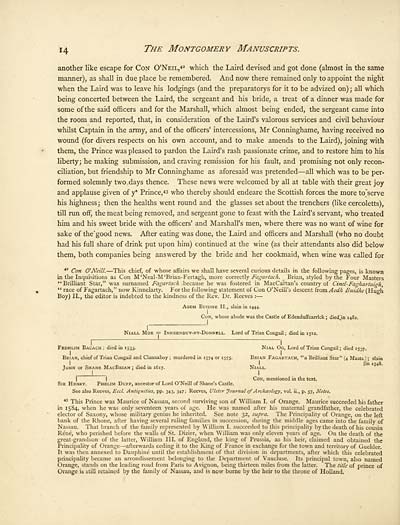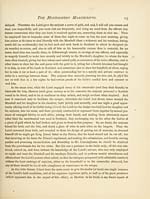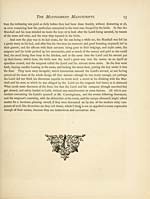Montgomery manuscripts
(28) Page 14
Download files
Complete book:
Individual page:
Thumbnail gallery: Grid view | List view

14 The Montgomery Manuscripts.
another like escape for Con O'Neil,* 2 which the Laird devised and got done (almost in the same
manner), as shall in due place be remembered. And now there remained only to appoint the night
when the Laird was to leave his lodgings (and the preparatorys for it to be advized on); all which
being concerted between the Laird, the sergeant and his bride, a treat of a dinner was made for
some of the said officers and for the Marshall, which almost being ended, the sergeant came into
the room and reported, that, in consideration of the Laird's valorous services and civil behaviour
whilst Captain in the army, and of the officers' intercessions, Mr Conninghame, having received no
wound (for divers respects on his own account, and to make amends to the Laird), joining with
them, the Prince was pleased to pardon the Laird's rash passionate crime, and to restore him to his
liberty; he making submission, and craving remission for his fault, and promising not only recon-
ciliation, but friendship to Mr Conninghame as aforesaid was pretended — all which was to be per-
formed solemnly two days thence. These news were welcomed by all at table with their great joy
and applause given of y 8 Prince, « who thereby should endeare the Scottish forces the more to'serve
his highness; then the healths went round and the glasses set about the trenchers (like cercoletts),
till run off, the meat being removed, and sergeant gone to feast with the Laird's servant, who treated
him and his sweet bride with the officers' and Marshall's men, where there was no want of wine for
sake of the' good news. After eating was done, the Laird and officers and Marshall (who no doubt
had his full share of drink put upon him) continued at the wine (as their attendants also did below
them, both companies being answered by the bride and her cookmaid, when wine was called for
*' Con O'Neill. — This chief, of whose affairs we shall have several curious details in the following pages, is known
in the Inquisitions as Con M'Neal-M'Brian-Fertagh, more correctly Fagartach. Brian, styled by the Four Masters
"Brilliant Star," was surnamed Fagartach because he was fostered in MacCartan's country oi Cinel-Faghartaigh,
" race of Fagartach, " now Kinnelarty. For the following statement of Con O'Neill's descent IxoxaAodh Buid/ie (Hugh
Boy) II., the editor is indebted to the kindness of the Rev. Dr. Reeves :—
Aodh Buidhe II., slain in 1444.
Con, whose abode was the Castle of Edenduffcarrlck : died'in 1482.
1
Niall Mor =j= Inneenduv-ny-Donnell. Lord of Trian Congail ; died in 1512.
Fedhlim Bacach ; died in 1533. Nial Og, Lord of Trian Congail ; died 1537.
Brian, chief of Trian Congail and Clannaboy ; murdered in 1574 or 1575. Brian Fagartach, "a Brilliant Star" (4 Masts.) ; slain
I I [in 1548.
John or Shane MacBrian ; died in 1617. Niall.
I I _ Con, mentioned in the text.
Sir Henry. Phelim Duff, ancestor of Lord O'Neill of Shane's Castle.
See also Reeves, Eccl. Antiquities, pp. 343, 347; Reeves, Ulster Jottrnal of Archceology, vol. ii., p. 57, Notes.
43 This Prince was Maurice of Nassau, second surviving son of William I. of Orange. Maurice succeeded his father
in 1584, when he was only seventeen years of age. He was named after his maternal grandfather, the celebrated
elector of Saxony, whose military genius he inherited. See note 32, supra. The Principality of Orange, on the left
bank of the Rhone, after having several ruling families in succession, during the middle ages came into the family of
Nassau. That branch of the family represented by William I. succeeded to this principality by the death of his cousin
Rene, who perished before the walls of St. Dizier, when William was only eleven years of age. On the death of the
great-grandson of the latter, William III. of England, the king of Prussia, as his heir, claimed and obtained the
Principality of Orange — afterwards ceding it to the King of France in exchange for the town and territory of Guelder.
It was then annexed to Dauphine until the establishment of that division in departments, after which this celebrated
principality became an arrondissement belonging to the Department of Vaucluse. Its principal town, also named
Orange, stands on the leading road from Paris to Avignon, being thirteen miles from the latter. The title of prince of
Orange is still retained by the family of Nassau, and is now borne by the heir to the throne of Holland.
another like escape for Con O'Neil,* 2 which the Laird devised and got done (almost in the same
manner), as shall in due place be remembered. And now there remained only to appoint the night
when the Laird was to leave his lodgings (and the preparatorys for it to be advized on); all which
being concerted between the Laird, the sergeant and his bride, a treat of a dinner was made for
some of the said officers and for the Marshall, which almost being ended, the sergeant came into
the room and reported, that, in consideration of the Laird's valorous services and civil behaviour
whilst Captain in the army, and of the officers' intercessions, Mr Conninghame, having received no
wound (for divers respects on his own account, and to make amends to the Laird), joining with
them, the Prince was pleased to pardon the Laird's rash passionate crime, and to restore him to his
liberty; he making submission, and craving remission for his fault, and promising not only recon-
ciliation, but friendship to Mr Conninghame as aforesaid was pretended — all which was to be per-
formed solemnly two days thence. These news were welcomed by all at table with their great joy
and applause given of y 8 Prince, « who thereby should endeare the Scottish forces the more to'serve
his highness; then the healths went round and the glasses set about the trenchers (like cercoletts),
till run off, the meat being removed, and sergeant gone to feast with the Laird's servant, who treated
him and his sweet bride with the officers' and Marshall's men, where there was no want of wine for
sake of the' good news. After eating was done, the Laird and officers and Marshall (who no doubt
had his full share of drink put upon him) continued at the wine (as their attendants also did below
them, both companies being answered by the bride and her cookmaid, when wine was called for
*' Con O'Neill. — This chief, of whose affairs we shall have several curious details in the following pages, is known
in the Inquisitions as Con M'Neal-M'Brian-Fertagh, more correctly Fagartach. Brian, styled by the Four Masters
"Brilliant Star," was surnamed Fagartach because he was fostered in MacCartan's country oi Cinel-Faghartaigh,
" race of Fagartach, " now Kinnelarty. For the following statement of Con O'Neill's descent IxoxaAodh Buid/ie (Hugh
Boy) II., the editor is indebted to the kindness of the Rev. Dr. Reeves :—
Aodh Buidhe II., slain in 1444.
Con, whose abode was the Castle of Edenduffcarrlck : died'in 1482.
1
Niall Mor =j= Inneenduv-ny-Donnell. Lord of Trian Congail ; died in 1512.
Fedhlim Bacach ; died in 1533. Nial Og, Lord of Trian Congail ; died 1537.
Brian, chief of Trian Congail and Clannaboy ; murdered in 1574 or 1575. Brian Fagartach, "a Brilliant Star" (4 Masts.) ; slain
I I [in 1548.
John or Shane MacBrian ; died in 1617. Niall.
I I _ Con, mentioned in the text.
Sir Henry. Phelim Duff, ancestor of Lord O'Neill of Shane's Castle.
See also Reeves, Eccl. Antiquities, pp. 343, 347; Reeves, Ulster Jottrnal of Archceology, vol. ii., p. 57, Notes.
43 This Prince was Maurice of Nassau, second surviving son of William I. of Orange. Maurice succeeded his father
in 1584, when he was only seventeen years of age. He was named after his maternal grandfather, the celebrated
elector of Saxony, whose military genius he inherited. See note 32, supra. The Principality of Orange, on the left
bank of the Rhone, after having several ruling families in succession, during the middle ages came into the family of
Nassau. That branch of the family represented by William I. succeeded to this principality by the death of his cousin
Rene, who perished before the walls of St. Dizier, when William was only eleven years of age. On the death of the
great-grandson of the latter, William III. of England, the king of Prussia, as his heir, claimed and obtained the
Principality of Orange — afterwards ceding it to the King of France in exchange for the town and territory of Guelder.
It was then annexed to Dauphine until the establishment of that division in departments, after which this celebrated
principality became an arrondissement belonging to the Department of Vaucluse. Its principal town, also named
Orange, stands on the leading road from Paris to Avignon, being thirteen miles from the latter. The title of prince of
Orange is still retained by the family of Nassau, and is now borne by the heir to the throne of Holland.
Set display mode to:
![]() Universal Viewer |
Universal Viewer | ![]() Mirador |
Large image | Transcription
Mirador |
Large image | Transcription
Images and transcriptions on this page, including medium image downloads, may be used under the Creative Commons Attribution 4.0 International Licence unless otherwise stated. ![]()
| Histories of Scottish families > Montgomery manuscripts > (28) Page 14 |
|---|
| Permanent URL | https://digital.nls.uk/95233263 |
|---|
| Description | A selection of almost 400 printed items relating to the history of Scottish families, mostly dating from the 19th and early 20th centuries. Includes memoirs, genealogies and clan histories, with a few produced by emigrant families. The earliest family history goes back to AD 916. |
|---|

